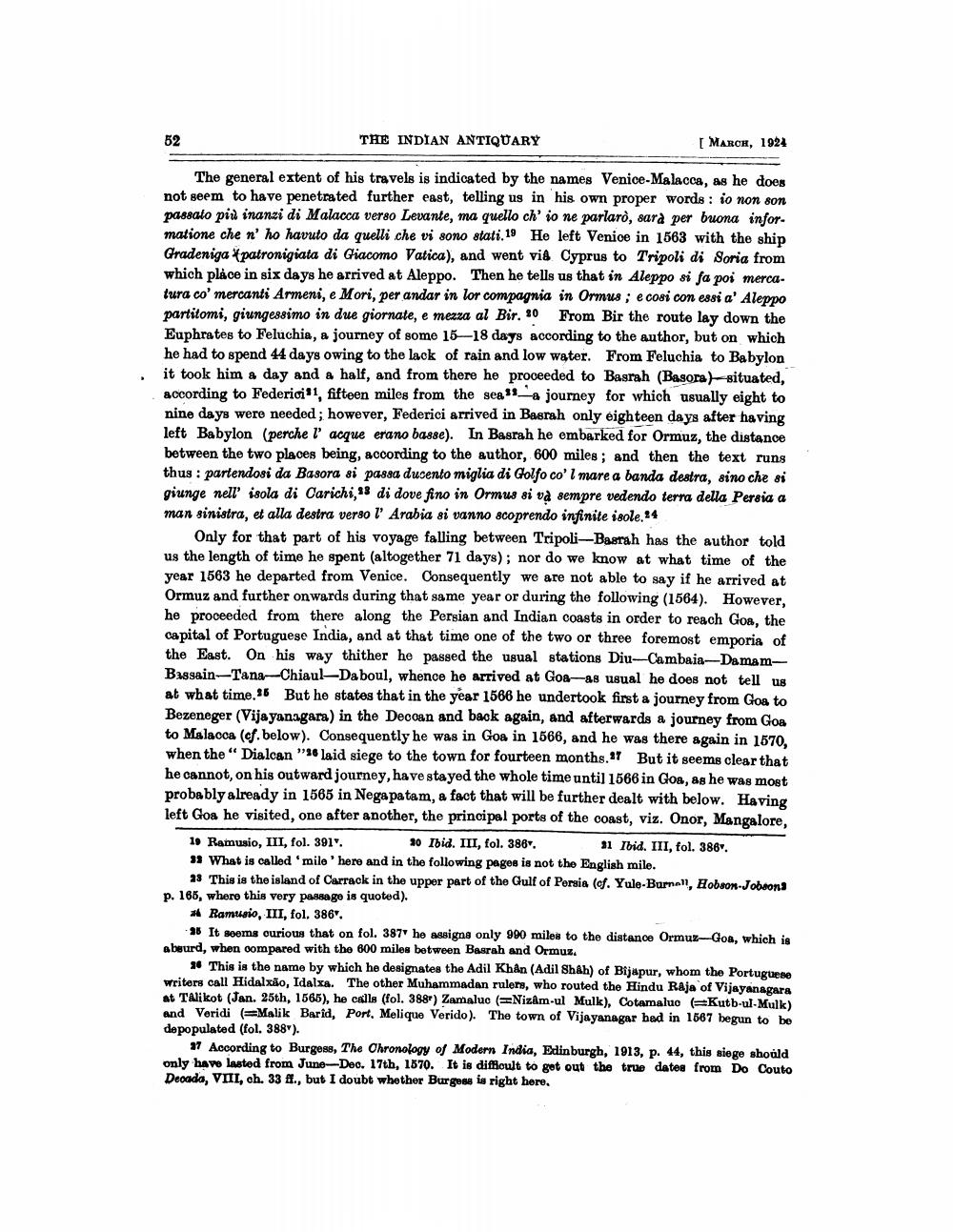________________
52
THE INDIAN ANTIQUARY
MARCH, 1924
The general extent of his travels is indicated by the names Venice-Malacca, as he does not seem to have penetrated further east, telling us in his own proper words : io non son passato più inanzi di Malacca verso Levante, ma quello ch' io ne parlarò, sarà per buona informatione che n' ho havuto da quelli che vi sono stati 19 He left Venioe in 1663 with the ship Gradeniga patronigiata di Giacomo Vatica), and went vi& Cyprus to Tripoli di Soria from which plåce in six days he arrived at Aleppo. Then he tells us that in Aleppo si fa poi mercatura co' mercanti Armeni, e Mori, per andar in lor compagnia in Ormus ; e cosi con essi a' Aleppo partitomi, giungessimo in due giornate, e mezza al Bir. 10 From Bir the route lay down the Euphrates to Feluchia, a journey of some 15-18 days according to the author, but on which he had to spend 44 days owing to the lack of rain and low water. From Feluchia to Babylon it took him a day and a half, and from there he proceeded to Basrah (Basora)- situated, according to Federici'1, fifteen miles from the sea si-a journey for which usually eight to nine days were needed; however, Federici arrived in Basrah only eighteen days after having left Babylon (perche l' acque erano basse). In Basrah he embarked for Ormuz, the distance between the two places being, according to the author, 600 miles; and then the text runs thus : partendosi da Basora si passa ducento miglia di Golfo co' l mare a banda destra, sino che si giunge nell'isola di Carichi, di dove fino in Ormus si va sempre vedendo terra della Persia a man sinistra, et alla destra verso l' Arabia si vanno scoprendo infinite isole.14
Only for that part of his voyage falling between Tripoli-Basrah has the author told us the length of time he spent (altogether 71 days); nor do we know at what time of the year 1563 he departed from Venice. Consequently we are not able to say if he arrived at Ormuz and further onwards during that same year or during the following (1564). However, he proceeded from there along the Persian and Indian coasts in order to reach Goa, the capital of Portuguese India, and at that time one of the two or three foremost emporia of the East. On his way thither he passed the usual stations Diu-Cambaia-DamamBussain-Tana-Chiaul-Daboul, whence he arrived at Goa-as usual he does not tell us at what time. But he states that in the year 1566 he undertook first a journey from Goa to Bezeneger (Vijayanagara) in the Deccan and back again, and afterwards a journey from Goa to Malacca (cf. below). Consequently he was in Goa in 1666, and he was there again in 1570, when the "Dialcan 26 laid siege to the town for fourteen months. But it seems clear that he cannot, on his outward journey, have stayed the whole time until 1566 in Goa, ag he was most probably already in 1565 in Negapatam, a fact that will be further dealt with below. Having left Goa he visited, one after another, the principal ports of the coast, viz. Onor, Mangalore,
19 Ramusio, III, fol. 3914. 20 Ibid. III, fol. 386v. 21 Ibid. III, fol. 386. 31 What is called 'milo' here and in the following pages is not the English milo.
28 This is the island of Carrack in the upper part of the Gulf of Persia (cf. Yule-Burnell, Hobson-Jobmons p. 165, where this very passage is quoted).
* Ramusio, III, fol. 3867.
36 It seems ourious that on fol. 387 he assigns only 990 miles to the distance Ormuz-Goa, which is abeurd, when compared with the 600 miles between Basrah and Ormuz.
29 This is the name by which he designates the Adil Khan (Adil ShAh) of Bijapur, whom the Portuguese writers call Hidalxão, Idalxa. The other Muhammadan rulers, who routed the Hindu Raja of Vijayanagara at Talikot (Jan. 25th, 1565), he calls (fol. 388) Zamaluo (Nizam-ul Mulk), Cotamaluo (Kutb-ul-Mulk) and Veridi (Malik Barid, Port, Melique Verido). The town of Vijayanagar bed in 1967 begun to be depopulated (fol. 388).
17 According to Burgess, The Chronology of Modern India, Edinburgh, 1913, p. 44, this siege should only have lasted from June-Deo. 17th, 1870. It is difficult to get out the true dates from Do Couto Deoada, VIII, ch. 33 ff., but I doubt whether Burgess is right here.




